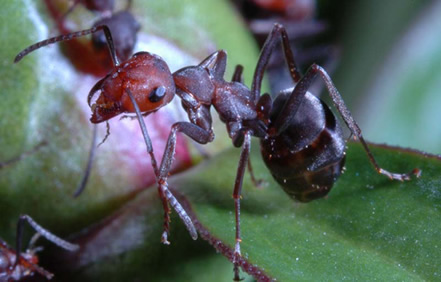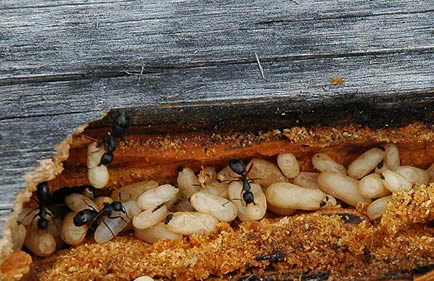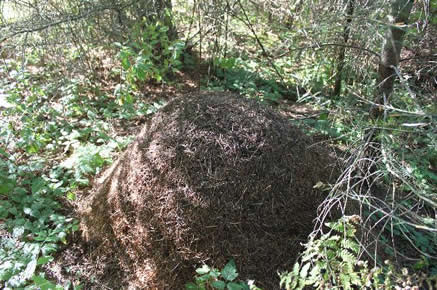

THE ANTS OF BRITISH COLUMBIA: ABUNDANCE, SIGNIFICANCE AND ECOLOGICAL DIVERSITY

European Fire Ant (Myrmica rubra), photo by Rob Higgins
by
Staffan Lindgren
University of Northern British Columbia
lindgren@unbc.ca
View the checklist of the Ants of BC (PDF)
Visit Rob Higgins Ants of British Columbia home page
Read about the European Fire Ant in BC (Higgins)
Read about ants in the central interior of BC (Lindgren)
Read a paper on ants and the Williamson's Sapsucker (Higgins)
General information
The ants (Hymenoptera: Formicidae) are perhaps the most successful of all extant insects. There are approximately 8,800 described species of ants (Hölldobler and Wilson 1990), of which approximately 580 species are found in North America (Smith 1979). In most areas of the world, ants are among the most dominant of biota. But it is not in terms of diversity that they dominate, but rather in abundance, and in many areas they make up a significant portion of total biomass. The key to the success of ants is without doubt their social structure. Each ant colony effectively functions as a superorganism, with all individuals working for the common good of the colony.
Most people have encountered ants in a negative context, e.g., when discovering that the lovely picnic site was actually on top of an ant nest. Carpenter ants are serious structural pests in some areas (Hansen and Klotz 2005). However, ants are central to ecosystem function, and in many ecosystems they are keystone species, i.e., their removal from the ecosystem would significantly alter its function, with many other organisms impacted negatively.
Ants perform numerous important ecological functions. Their occurrence as staple food for many birds, e.g., the pileated woodpecker (Torgersen and Bull 1995), is an indication of their significance in ecosystem function. Ants are also an important dietary component for bears. For example, Raine and Kansas (1990, p. 299) found that "The ant season was found to occur from mid-June to mid- to late July, when berries began to ripen. Ants and ant larvae were the main food items observed to be eaten by bears during this season. Bears searched for ants in old logs and under stones." In Oregon, black bears depend on ants throughout late summer and fall if the berry crop is poor (T. Torgersen, pers. comm.), and grizzly bears in the Prince George area feed on ants when succulent herbal growth becomes sparse, and berries are not yet available, in late summer (L. Ciarniello, pers. comm.).
Carpenter ants are among the dominant ants in sub-boreal forests, where they are perhaps the most important organisms in physically breaking down wood. In the Prince George area, Camponotus herculeanus dominates in most forest types, while we have found C. modoc in a dry Douglas-fir stand on a south-facing slope. C. vicinus was also found on this slope, but this species nests under rocks.
Many species of ants are fierce predators, and as such can be beneficial. For example, ants accounted for 85 % reduction of pupae of two defoliating moths in studies in Washington and Oregon (Campbell and Torgersen 1982, Torgersen et al. 1990). Smaller species of ants (Myrmica and Leptothorax species) prey on small arthropods, e.g., we have observed them preying on springtails (Collembola).
Ants in the genera Formica and Camponotus are commonly seen carrying prey. Species in both of these genera can have huge nests, containing tens of thousands of workers, so it is conceivable that they have significant impact on forest health by preying on the caterpillars of important defoliators, at least locally.
Ants affect their environment in profound ways. In several studies, ants have been shown to equal or surpass earthworms in the amount of soil they transport to the surface (Thorp 1949). As soil dwellers, ants affect mixing, mineral cycling, aeration, chemistry, and drainage of soil, but they also affect the fauna and flora. With regard to the latter, many plants are adapted to have their seeds dispersed by ants. Many ant species tend aphids and their relatives (Homoptera) for their honeydew. In return, the aphids are protected by the ants from predators and parasites. Ants sometimes actively move aphids from plant to plant.
In the Prince George area, ants in the genera Formica and Camponotus can be seen tending to aphid colonies almost everywhere. The presence of ants protects the aphids, and particularly Formica species aggressively defend their aphid colonies. Surprisingly, the larger Camponotus herculeanus workers tend to abandon the aphids, rather than sacrificing their lives. Other species of Camponotus can be very aggressive (Hansen and Klotz 2005).

Formica ravida, photo by Rob Higgins.
Ants of British Columbia
Knowledge of the ants of British Columbia is poor at best. Using published information, existing collections, and personal collections, Naumann et al. (1999) list 92 species known or expected to occur in British Columbia. This number is lower than lists from areas in the United States in spite of the fact that the diversity of habitats found in British Columbia is very high, and one could expect a correspondingly high diversity of ants.
Ants of Central Interior British Columbia
The insect fauna of Central Interior and Northern British Columbia is very poorly known. It is not surprising then, that very little is known about the ants of this region. Very few collections of ants have been made north of the Chilcotin, so it is difficult to estimate the number of ant species present in this region. Based on collections, Francoeur (1997) estimated a minimum of 25 species of ants in the Yukon. Similar numbers are likely in the Central Interior of British Columbia. To date, we have found 23 species in three subfamilies near Prince George, and an additional number of species near Houston, BC, and Williams Lake, BC.
Ants utilizing dead wood
Many ants utilize dead wood for nest construction. The most well-known of these are the carpenter ants, Camponotus spp. These large, but often shy and non-aggressive ants construct their nests in decayed logs or standing trees, including heart-rotted live trees. Many other ants also utilize wood, e.g., species in the genus Formica often nest in stumps or coarse woody debris.
In a preliminary survey of ants (Lindgren and MacIsaac 2002), we found that dead wood is a preferred nest substrate for most ant species. Pieces as small as 10 x 10 cm may contain nests of the small Leptothorax muscorum (= canadensis) (Subfamily Myrmicinae). These ants are also frequently found in association with larger ants of many species, usually near the surface of the wood. Myrmica species are also commonly found in dead wood of all sizes. We frequently found several species under the bark in stumps less than a year old.
Of the ants in the Subfamily Formicinae, Formica species, particularly the facultative slave-maker Formica aserva (=subnuda) and the circumpolar carpenter ant species Camponotus herculeanus are found in larger pieces, e.g., stumps. Large Formica nests can be readily recognized by the presence of the active workers, accumulations of thatching materials, and sawdust, whereas Camponotus nests and the nests of ants in the Formica fusca group are often discovered only when the wood is broken open. All of these species appear to prefer wood that has some level of structural integrity.
Thatching ants, i.e., ants in the genus Formica that make thatch mound nests, are a dominant component of the arthropod diversity in Fennoscandia. In northern British Columbia, and indeed in North America, they are only locally dominant (Jurgensen et al 2005). The western thatching ant, Formica obscuripes, is a relatively widespread representative of this group in north central BC. It is often locally dominant in pine stands with sandy soils, but is absent in many areas with apparently suitable habitat. Like its Eurasian counterparts, this species can construct impressive thatch mound nests.
Formica argentea is a medium-sized, black ant, which nests in the soil, often constructing fairly large soil mound nests. In many cases, even these nests appear to have originated in wood, but in some cases the nests have been founded under a rock or other suitable substrate. On exposed (disturbed), sandy sites, the nests of these ants can be a prominent feature.
The obligate slave-maker Polyergus breviceps appears to favor clearcuts, where we have found it nesting in stumps along with its slaves, normally Formica neorufibarbis. Formica neorufibarbis also appears to be a favorite slave of Formica aserva. Formica neorufibarbis is common in woody debris, but its populations appear to be suppressed by Formica aserva a few years after establishing in clearcuts.
The small Lasius pallitarsis is common in moist wood with advanced decay, often subterranean. Another species in this genus, Lasius subumbratus, was found in rich soil among plant roots, where these ants presumably tend to root aphids, and also in a grizzly bear scat (unpublished data). They are likely common, but are rarely encountered due to their cryptic habits.
Tapinoma sessile, the odorous house ant, is very widespread in North America, and is the only representative of the Subfamily Dolichoderinae in north central British Columbia. In spite of its diminutive size, this ant can be rather aggressive. Because of its small size, it is easily overlooked. Nests are often found in association with wood, but we have found the majority of nests under moss or in soil.
Several other species have been found locally or scattered. All species found to date in central and north central BC are listed on this species page.

Boreal Carpenter Ant (Camponotus herculeanus), photo by Rob Higgins
Commonly seen ants
The ants most commonly seen are those that occur in and around human dwellings and in cities. Carpenter ants comprise the huge genus Camponotus, and get their name as a result of the habit of many common species to nest in wood, including human dwellings. In southern and coastal BC, Camponotus modoc is the most common species, whereas the circumboreal Boreal Carpent Ant ( Camponotus herculeanus) is the dominant species in cooler regions in the north. Most commonly, people notice carpenter ants when the reproductives swarm in spring, but since nests can be quite large (50,000 workers or more for some species) workers are also noticeable around well established nests. When nesting in the wall voids or wooden structures of homes, they sometimes appear indoors, sometimes in large numbers, when the weather outside is cold. Ants in the large genus Formica are also commonly seen; black, soil-nesting ants in the Formica fusca-group are common in disturbed habitats (including cities), and red wood ants often dominate forested habitats. The former are usually medium-sized, black ants, while the latter are the familiar ants with a red head and thorax and a brown or black gaster. Some of the latter also build prominent and often long-lasting thatch mounds.
When you see ants tending aphids, they are usually carpenter ants or Formica ants. Many species of ants invade homes, but some do this more commonly than others, e.g., the small odorous house ant, Tapinoma sessile (belonging to the subfamily Dolichoderinae and a species more or less ubiquitous throughout North America), and various species in the genus
Lasius (Formicinae). The former are small black ants which scurry around and get their common name from a characteristic odour they give off, while the latter are a little bit larger, commonly brownish and somewhat less agile. Ants in the subfamily Myrmicinae tend to be less noticeable. These ants, which are often reddish in colour, have a stinger like wasps (and some can inflict painful stings in spite of their small size), are usually slower-moving and somewhat more cryptic with small nests (100’s of workers), but many are commonly seen in cities as well, e.g., where their nest-entrances are located in sidewalk-cracks and between paving stones.

Insulated, temperature-regulated anthill of a species in the
Formica rufa species group (possibly
Formica obscuripes) from Langley, BC.
"In the spring when snow and ice is still present on the surface of the mound, the colony will become active and temperatures will rise to around 30 deg C overnight." (Robert Higgins, pers. comm. 2011). Photo by Celeste Paley.
Ant Information Sources
Information on ants is available from many sources. A recommended in-depth book is Hölldobler and Wilson's (1990) Pulitzer Prize-winning book The Ants. Their popular science book Journey to the Ants (Hölldobler and Wilson 1994) is highly recommended for a less technical review of ant biology.
A slightly different, but highly worthwhile book is The Earth Dwellers. Adventures in the Land of the Ants by Erich Hoyt. In this book, Hoyt takes an ant's view of the world, but of more interest is the portrayal of myrmecological history, highlighted by warm, personal accounts of E.O. Wilson and William Brown of Cornell, which he weaves into the story. In another book, Deborah Gordon, Stanford University, describes her life's work on harvester ants in her easily digestible book Ants at Work: How an Insect Society is Organized, which also provides an insight into how science progresses. Used copies of many of these books can often be found at competitive prices through the Advanced Book Exchange (http://www.abebooks.com) or through http://www.amazon.com.
The video Little Creatures Who Run the World, featuring the eminent Harvard University myrmecologist Edward O. Wilson, is also recommended as an easily digestible source of information on the fascinating world of ants, as is The Ultimate Guide to Ants. Numerous web pages, e.g., the Social Insects web and the Ants of Cowling Arboretum and McKnight Prairie, present information on ants. The Myrmecology page has lots of information, including how to build observation nests.
Stunning photographs of ants can be found at Alex Wild’s myrmecos.net – this page is a must for ant afficionados.
Additional Links
Selected Literature
A fantastic searchable database of ant literature is Formis
Bolton, B. 1994. Identification guide to the ant genera of the world. Harvard University Press, Cambridge, MA, 222 pp.
Campbell, R.W., and T. Torgersen. 1982. Some effects of predaceous ants on western spruce budworm pupae in north central Washington. Environmental Entomology 11: 111-114.
Francoeur, A. 1997. Ants of the Yukon. Pp. 901-910 in H.V. Danks and J.A. Downes (eds.), Insects of the Yukon, Biological Survey of Canada (terrestrial Arthropods), Ottawa, 1034 pp.
Gordon, D.M. 1999. Ants at Work: How an Insect Society is Organized. Free Press, NY, 182 pp.
Hansen, L.D. and J.H. Klotz. 2005. Carpenter Ants of the United States and Canada. Cornell University Press, 204 pp.
Hoyt, E. 1996. The Earth Dwellers. Adventures in the Land of the Ants. Simon and Schuster, NY, 271 pp. + Appendix and glossary.
Hölldobler, B. and E.O. Wilson. 1990. The Ants. Harvard University Press, Cambridge, MA, 732 pp.
Hölldobler, B.; Wilson, E.O. 1994. Journey to the ants. The Belknap Press of the Harvard University Press, Cambridge, MA., 228 pp.
Jurgensen, MF, AJ Storer, and AC Risch. 2005. Red wood ants in North America. Annales Zoologici Fennica 42: 235-242.
Lindgren, B.S.; MacIsaac, A.M. 2002. A preliminary study of ant diversity and abundance, and their dependence on dead wood in central interior British Columbia. Pp. 111-119 In: Shea, P.J., W.F. Laudenslayer, Jr., B. Valentine, C. P. Weatherspoon, and T.E. Lisle [eds.], Symp. Proc.: Ecology and Management of Dead Wood in Western Forests, USDA For. Serv. Gen. Tech. Rep. PSW-181, Pac. SW. Res. Stn., Albany, CA
Naumann, K.; Preston, W.P.; Ayre, G.L. 1999. An annotated checklist of the ants (Hymenoptera: Formicidae) of British Columbia. Journal of the Entomological Society of British Columbia 96: 29-68.
Raine, R.M.; Kansas, J.L.. 1990. Black bear seasonal food habits and distribution by elevation in Banff National Park, Alberta. Int. Conf. Bear Res. And Manage. 8:297-304.
Smith, D.R. 1979. Formicoidea. In K.V. Krombein, P.D. Hurd, Jr., D.R. Smith, and B.D. Burks (eds.). Catalog of Hymenoptera in North America north of Mexico. Vol. 2. Apocrita (Aculeata), 1323-1467, Washington, DC.
Thorp, J. 1949. Effects of certain animals that live in soils. In J.V. Drew (ed.), Selected papers in soil formation and classification., No. 1, SSSA Special Publication Series, 1967, Madison, WI.
Torgersen, T., and E.L. Bull. 1995. Down logs as habitat for forest-dwelling ants - the primary prey of Pileated Woodpeckers in northeastern Oregon. Northwest Science 69: 294-303.
Torgersen, T., R.R. Mason, and R.W. Campbell. 1990. Predation by birds and ants on two forest insect pests in the Pacific Northwest. Studies in Avian Biology 13: 14-19.
Please cite these pages as:
Author, date, page title. In: Klinkenberg, Brian. (Editor) 2023. E-Fauna BC: Electronic Atlas of the Fauna of British Columbia [www.efauna.bc.ca]. Department of Geography, University of British Columbia, Vancouver. [Date Accessed]
© Copyright 2023 E-Fauna BC.